
The Power of Bilateral Olfaction
While we often take our sense of smell for granted, it is a powerful tool that helps us navigate the world around us. As humans and animals, we have two nostrils that work together to provide us with a rich and nuanced olfactory experience. But how exactly does the brain integrate information from these two sensory inputs? Researchers have recently uncovered some fascinating insights into how the olfactory cortex, a key region in the brain responsible for processing smell, coordinates signals from both sides of the nose.
Olfaction, the sense of smell, is a complex process that begins when odor molecules enter the nasal cavity and bind to receptors on olfactory sensory neurons. These neurons then send signals to the olfactory bulb, the first stop in the olfactory processing pathway. From there, information is relayed to the olfactory cortex, where the real magic happens.
Unlike the visual or auditory cortex, which have neat, topographical maps of the outside world, the olfactory cortex is a bit of a jumble. Odor information from the olfactory bulb is distributed in a disorganized manner, with no clear spatial organization. This poses an interesting challenge for how the brain integrates information from the two nostrils.
Bilateral Integration in the Olfactory Cortex
Recent research, conducted by a team of scientists and published in eNeuro and bioRxiv, sheds light on this problem. The researchers found that despite the distributed and fragmented nature of odor representations in the olfactory cortex, the information arriving from the two nostrils is actually highly coordinated.
Using a clever setup that allowed them to selectively stimulate one nostril at a time in awake mice, the researchers recorded the activity of individual neurons in two key regions of the olfactory cortex: the anterior olfactory nucleus (AON) and the anterior piriform cortex (APC). What they discovered was quite remarkable.
A sizable fraction of the neurons they recorded showed highly correlated responses to odors presented to the ipsilateral (same side) versus contralateral (opposite side) nostril. In other words, these neurons had “bilaterally aligned” receptive fields, responding in a similar way regardless of which nostril was stimulated.
Further analysis revealed that this bilateral alignment was not just a quirk of a few neurons; it was a widespread feature of the olfactory cortex. The researchers found that a significant proportion of neurons in both the AON and APC exhibited this bilateral matching of odor responses.
Decoding Odor Identity Across Sides
But the story doesn’t end there. The researchers also found that this bilateral alignment of receptive fields had functional consequences. Using a technique called linear decoding, they showed that odor identity could be accurately decoded from the population activity of olfactory cortex neurons, even when the decoder was trained on data from one nostril and tested on data from the other.
In other words, the brain’s representation of odor identity is so well-coordinated across the two hemispheres that information from one side can be used to predict the response on the other side. This suggests that the olfactory cortex is able to maintain a coherent, side-invariant representation of odor information, despite the disorganized nature of the sensory input it receives.
Interestingly, the researchers also found that while the odor responses were highly aligned, there were still enough differences between the ipsilateral and contralateral representations to allow the decoder to accurately determine which nostril the odor was presented to. This implies that the olfactory cortex is able to maintain both a unified olfactory percept and information about the spatial origin of the odor stimulus.
Computational Modeling of Bilateral Integration
To better understand the mechanisms underlying this bilateral alignment of receptive fields, the researchers turned to computational modeling. They built a model of the olfactory system, with two simulated olfactory cortices connected by a “Hebbian” matrix – a type of connectivity that reflects the idea of neurons that “fire together, wire together.”
The model showed that purely random connections between the two cortices would not be able to reproduce the strong bilateral matching observed in the experimental data. Instead, the model suggested that some degree of structured, experience-dependent connectivity between the two hemispheres is necessary to account for the findings.
In other words, the brain seems to use Hebbian-like plasticity – the strengthening of connections between neurons that are activated together – to forge links between the representations of the same odors in the left and right olfactory cortices. This allows for the remarkable bilateral alignment of odor responses observed in the experimental data.
Implications and Future Directions
The discovery of this bilateral alignment of receptive fields in the olfactory cortex has important implications for our understanding of how the brain processes and integrates sensory information. It suggests that, even in systems without clear topographical organization, the brain can find ways to coordinate information from the two sides of the body to create a coherent perceptual experience.
This work also raises interesting questions about the functional significance of this bilateral integration. Does it allow animals to better localize odor sources? Or does it simply provide a more robust and reliable representation of odor identity, independent of the specific nostril stimulated? Further research will be needed to fully elucidate the behavioral relevance of this phenomenon.
Ultimately, this study highlights the remarkable flexibility and ingenuity of the brain in dealing with the challenges posed by different sensory modalities. By uncovering the mechanisms underlying bilateral integration in the olfactory system, it provides valuable insights into the general principles of how the brain constructs a unified perceptual experience from multiple, potentially disparate sensory inputs.
For students and parents at Stanley Park High School, this research serves as a fascinating example of the cutting edge of neuroscience and the incredible complexity of the human (and animal) brain. It demonstrates the power of interdisciplinary collaboration, combining experimental and computational approaches to tackle fundamental questions about how we perceive and make sense of the world around us.

